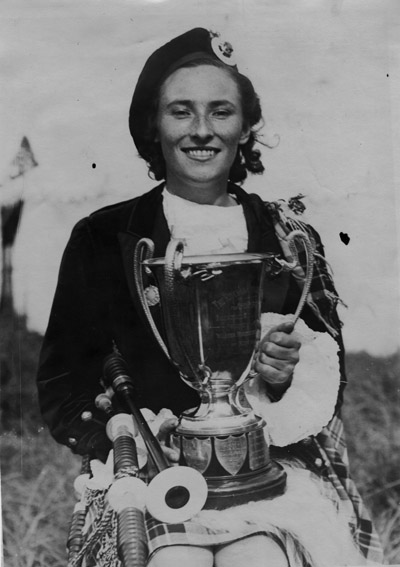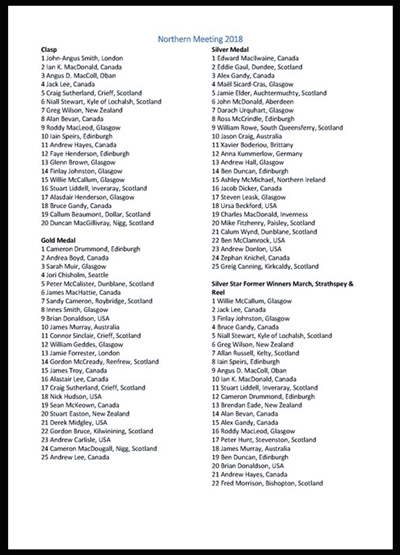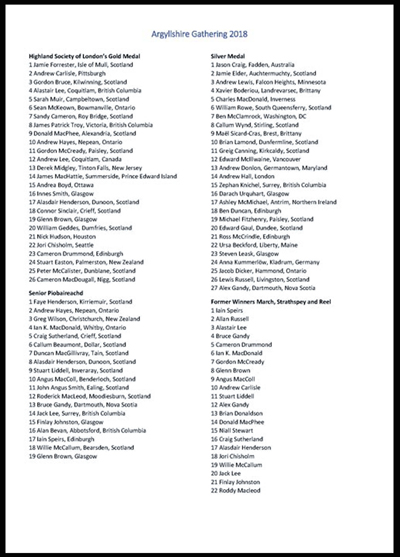Oban and Inverness lists beg the Q: Where are the women?

The entry and draws for the major solo piping competitions at the Argyllshire Gathering and Northern Meeting have been distributed to contestants, who inevitably have been on the edge of their kilts awaiting their place in orders-of-play.
Perhaps more interesting to the wider pipes|drums readership is the intriguing lack of female competitors.
While between 25 and 35 percent of pipers and drummers around the world are now women, the number of females competing at these and other top level UK competitions has actually declined since Great Britain’s Sexual Discrimination Act of 1976 made it illegal to bar women from the major gatherings.
Edith MacPherson was a pioneer of solo piping women, successfully competing around the games in Scotland in the 1940s and ’50 against some of the greatest names in the games. She was prohibited from participating in the major competitions simply because of her gender.
In 1976, three women – Rona Lightfoot (then MacDonald), Anne Johnston (Sinclair) and Anne Spalding (Stewart) – made history by rightfully competing in the Highland Society of London Gold Medal.
Forty-two years later, only two women – Andrea Boyd of Ottawa and Glasgow’s Sarah Muir – have entered and been accepted to the Gold Medal at Oban and Inverness, which cap their entries, respectively, at 26 and 25. That’s a participation rate of eight percent. Even more glaring, only one woman, Anna Kummerlöw of Germany, is in the Silver Medal events.

Because there still has been only one female winner of a Gold Medal, Faye Henderson in 2010, she is, by the rules, the only woman eligible to compete in the Senior Piobaireachd at Oban or the Clasp at Inverness.
+ Faye Henderson wins Oban Gold Medal – first ever female winner
So, in 42 years, the number of women competing in the world’s biggest solo piping events has actually decreased.
The continued gender imbalance in elite solo piping and snare drumming competitions is remarkable, especially in an age of heightened awareness and proactivity to correct antiquated and flawed traditions, sexual harassment and unfair cultures in the workplace, in associations, and essentially everywhere where they exist.
+ #MeToo: A collective call to members of our community
“Competing at a high level is hard. Bloody hard,” said a competitor who asked not to be identified. “It takes an enormous amount of time and money. When I look at ‘the cost’ in my life, I prioritize piping over a lot of other interests I have, like spending time with a partner, family, friends. Women like Margaret Dunn and Fiona Manson who have children have stopped competing – not because they don’t have supportive spouses who encourage them to keep going – but because they just have prioritized raising children.”
But why is it that women pipers seem to be expected to drop out, while males with the exact same responsibilities and interests far more often continue to pursue their competition piping avocation? Perhaps the answers are not that simple.
“Focusing on Gold Medal tunes is a rather self-indulgent pursuit, compared with spending evenings and weekends with their young children,” added the piper who spoke on condition of anonymity. “I think many men have prioritized the same thing – I know a lot of guys that for instance, who used to do solos and bands pre-children, but maybe just do one of the two while the kids are young. It is just more visible when women do it as there are fewer of us.”

The demands on a top-flight solo piper can be all-consuming, and at least half of those at the Clasp / Senior level have made their talent and art into a career, with teaching, performances, endorsements and even product design providing their primary source of income.
Gaining entry to the Gold Medal events and maintaining one’s place often means dropping just about everything to dedicate the commitment, focus, and probably above all, time to competition preparedness and success, whether male or female.
“Most of my top-flight competitive piping friends do not have other hobbies or interests – they don’t go to the gym, they don’t like to cook, they don’t engage in civil society with other organizations. They just have piping on the brain 24/7,” according to another piper speaking on condition his/her name is withheld.
Ten percent of the UK’s Competing Pipers Association is female, according to President Glenn Brown. As one of the world’s few all-soloist organizations, the CPA is in a different situation. The vast majority of the world’s piping and drumming associations govern pipe bands, a domain that has seen increased inclusion of women, right to the very top of Grade 1.
At the North American Championships at Maxville, Ontario, run by the Pipers & Pipe Band Society of Ontario, only three women are entered for the 31-contestant Professional solo piping events, or 10 percent. The situation is better in Grade 1 Amateur, with 21 percent of contestants being women, so why the attrition at the top?
But the lack of female solo competitors at the Professional or Open solo level can be seen in many, if not most, of the world’s associations. The phenomenon or problem certainly isn’t exclusive to the CPA and PPBSO. But if it is a concern, we don’t know of any organization proactively investigating the reasons and, if appropriate, working to fix the problem.
That there is still but one woman who’s won a Highland Society of London Gold Medal perhaps speaks more to the dearth of female competitors not only competing in the Silver and Gold Medal events, but in Professional/Open events worldwide than any other reason, such as more women pipers simply being not good enough or not delivering a tune on the day.
Maybe men and women are simply wired differently. Anyone who has tried to navigate competition piping, drumming and pipe bands will encounter a storm of politics, customs and not a little BS. In general, males might be on average more willing than women to put up with the frustration, politics and nonsense, such as teachers judging pupils and perceived or real gender bias, that can come with top-tier solo piping.
The last word goes to a current solo piping competitor: “Maybe call it men are from mars, women are from venus . . . I can’t explain it.”
What do you think? Is it worth studying the possible reasons why so many women might not want to continue to pursue solo competition into the top levels? Scroll down to use our comments tool.

If the author, or others, would like to learn more about the history of women in piping, I can make my PhD thesis available – at least in part, as it is my intention to publish it with the University of Edinburgh Press… you know, once my life becomes less hectic between my career (which is going fantastic!), and co-raising my 19 month old son with my own highly supportive partner. The thesis writes the history of women’s involvement with the pipes where it did not exist before except in smaller articles such as this. I touched on solos, but mostly focused on pipe bands, but there is also a great deal of discussion on some of the questions that you have pointed to here. As far as I know, it is the only (yet) existing comprehensive history of women’s history in piping/pipe bands.
I would be very interested in reading your PhD thesis. For a course in my final year of school, we do a personal interest project, and I’ve chosen to do gender and pipe bands. Your research would be extremely helpful for my project. Let me know if you are able to email, so we can further discuss. 🙂